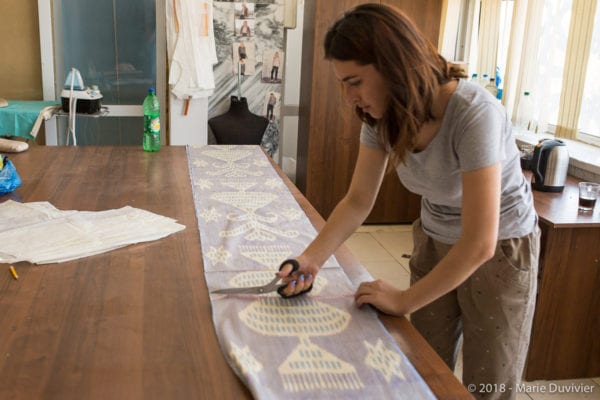
I discovered atlas and adras on my first trip to Uzbekistan in 2014. It was in the beautiful city of Bukhara. I loved atlas so much I got two large square scarves made of this very special silk fabric.
In 2018, during a trip around Tajikistan I specifically went to Khujand to visit an atlas fabric and later on, while buying some more in Dushanbe I found out what was the birthplace of this type of fabric and technique also known as ikat.
I kept a note for a future trip and made it back to Uzbekistan in 2019.
On this image: Nafisa, a young Tajik designer is cutting the adras (blend of cotton and silk) I bought to make a gorgeous scarf. As the width is approximately 60cm it needs to be carefully cut and assembled to make a large square scarf.
When I got to Tajikistan I had planned a stop in Khujand with my travel agent as he had told me this was the place to go to for atlas.
What I didn’t have though was a precise address or name. The driver and I headed to the local market and only found ready made items and not even the best kind.
So my guide asked around and we were advised to go to a particular shop where we were greeted very nicely but the place was hardly an active workshop. It was more of a display type of place.
The lady understood what I wanted and indeed gave us the directions to a local fabric. Initially state owned this factory was bought by a Tajik gentleman whose daughter kindly invited me in to visit as soon as I arrived.
In 2018 at the end of my trip in Tajikistan I went to a shop that had beautiful adras. I obviously couldn’t resist both buying some for yet another scarf and having a chat with the shop manager.
He explained that if I wanted to see atlas and adras hand weaving I would have to go back to the region of Uzbekistan called Fergana valley.
I took good note for a future trip and asked him for the time being where I could get my raw material transformed into my usual square-shaped scarf.
To my surprise the workshop he recommended was in a stadium. Nafisa did a beautiful work on this new piece of my collection (see picture at the top of the page).
August 2019, back in Uzbekistan for a special trip to the Fergana valley: this workshop was created during the 19th century. Adras weaving was forbidden under the soviet regime as Russians wanted to eradicate traditional attires. This art was revived after a UNESCO mission in 1987. The current owner of the workshop was an accountant for a few years towards the end of the soviet era and took it over in 1990.
Abr band ikat weaving: Abr means cloud and band means to tie.
Silk is produced by mulberry silkworms. Silk farming is called sericulture.
A few key figures about sericulture:
After these three days the best cocoons are extracted for reproduction purposes while the others are used to make threads for embroidery and weaving.
The cocoons are exposed to the sunlight for two days in order to kill the pupae. They are then immersed in boiling water for five minutes to extract the fine silk strands. Threads are then placed on reels. These reels are washed in water containing salt, cotton soap and washing soda. Another wash is made with baby powder in order to make the threads whiter and softer. The threads are then tied to a two-meter long stand where the craftsperson prepares the patterns before the coloring process.
The resist is formed by binding individual yarns or bundles of yarns with a tight wrapping applied in the desired pattern. The yarns are then dyed with natural colours. The bindings may then be altered to create a new pattern and the yarns dyed again with another colour. This process may be repeated multiple times to produce elaborate, multicolored patterns. When the dyeing is finished all the bindings are removed and the yarns are woven into cloth.
Atlas is 100% silk. A length of four meters can be woven in a full day of work.
Adras is a cotton and silk mix. A length of up to six meters can be woven in a full day.
Weavers are paid by the meter. They work approximately eight hours a day.
© 2020 Marie Duvivier All Rights Reserved